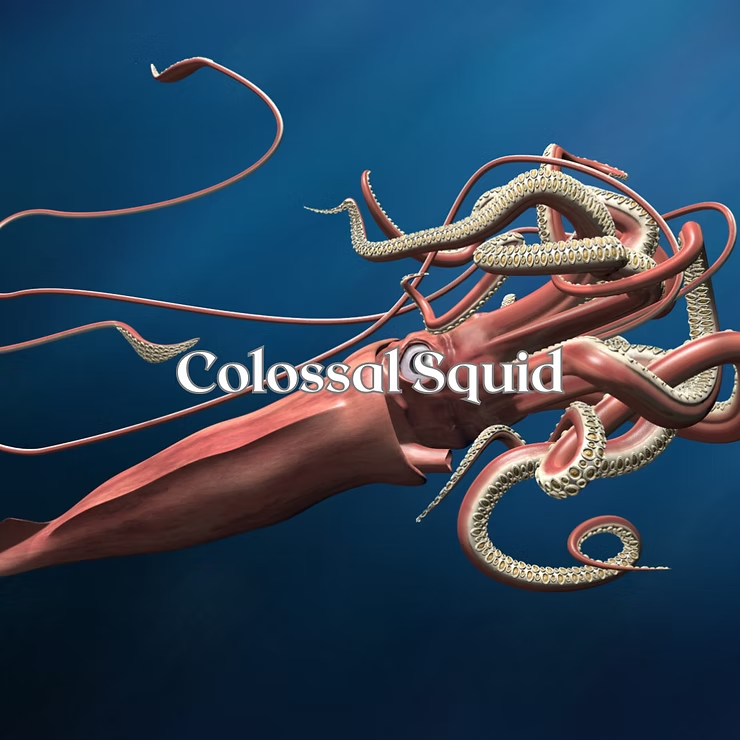Introduction
The Colossal Squid is one of the most mysterious and fascinating creatures of the deep sea. Known for its massive size, elusive nature, and unique adaptations, it has long intrigued scientists and captured the imagination of the public. This article explores the biology, habitat, diet, predators, reproduction, adaptations, myths, and conservation status of this extraordinary animal.
What is a Colossal Squid?
Size and Appearance
The Colossal Squid is among the largest invertebrates on Earth. Females can grow over 12 meters (39 feet), with some estimates reaching 14 meters (46 feet). They weigh up to 500 kilograms (1,100 pounds), making them one of the heaviest squid species. Their reddish-brown bodies are cylindrical, covered with thick gelatinous skin, and supported by powerful tentacles armed with hooks and toothed suckers.
Habitat
Unlike most squids found in shallower waters, the Colossal Squid thrives in the deep sea, typically at depths of 1,000 to 2,000 meters. They inhabit the Southern Ocean, particularly around Antarctica, where icy waters and immense pressure create a challenging environment. This habitat makes them extremely difficult to study, adding to their mystery.
Diet and Predators
Diet
The Colossal Squid is a formidable predator. Studies suggest they feed on large fish, other squid species, and possibly small whales. Their sharp beak and strong tentacles allow them to tear apart prey efficiently. Despite this knowledge, many aspects of their feeding behavior remain unknown due to their inaccessible habitat.
- Feeds on fish, crustaceans, and squid
- Possesses a powerful beak to slice prey
- Uses hooks and toothed suckers to capture victims
Predators
Despite their size, Colossal Squids are not without threats. Sperm whales are considered their primary predators, often bearing scars from battles. Other potential predators include large sharks and possibly orcas. Their ability to change skin color and patterns provides camouflage, offering some protection against detection.
Reproduction
The reproductive habits of the Colossal Squid remain largely unknown. Scientists believe males transfer spermatophores to females, who later fertilize their eggs. Females likely produce large gelatinous egg masses that drift or attach to the seafloor. Much about their life cycle remains speculative, as few specimens have ever been observed alive.
Unique Adaptations
- Giant Eyes: Measuring up to 11 inches across, the largest in the animal kingdom, designed for low-light vision.
- Bioluminescence: Specialized light-producing organs may help attract prey or deter predators.
- Camouflage: Chromatophores in their skin allow them to change color and pattern, blending into the deep sea.
- Hooked Tentacles: Lined with sharp teeth, giving them a deadly grip on prey.
Myths and Legends
The Colossal Squid has inspired myths of monstrous sea creatures attacking ships and devouring sailors. While rooted in exaggeration, these stories reflect the awe inspired by such a massive and elusive animal. In reality, the Colossal Squid is a predator of the deep, not a mythological terror.
Conservation Status
Little is known about the population status of Colossal Squids due to the challenges of studying them. They are not currently listed as endangered, and their deep-sea environment may provide some protection from human activity. However, continued research is essential to understand their ecological role and ensure they remain safeguarded from indirect threats such as climate change and ocean pollution.
Conclusion
The Colossal Squid is a true marvel of the deep ocean. With its enormous size, advanced adaptations, and enduring myths, it represents both the mystery and the power of life in Earth’s most extreme environments. While much remains unknown, every discovery brings us closer to unraveling the secrets of this legendary creature.
Frequently Asked Questions
- How big can Colossal Squids grow? Females may reach 13–14 meters, with males slightly smaller.
- Where do they live? Deep waters of the Southern Ocean, especially near Antarctica.
- What do they eat? Fish, other squids, and occasionally larger prey.
- Do they have predators? Mainly sperm whales, with some sharks and orcas as potential threats.
- What makes them unique? Giant eyes, bioluminescence, hooked tentacles, and powerful camouflage abilities.

